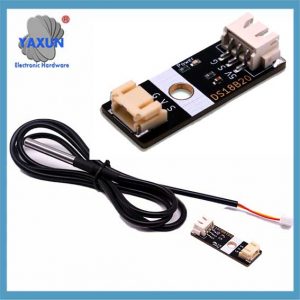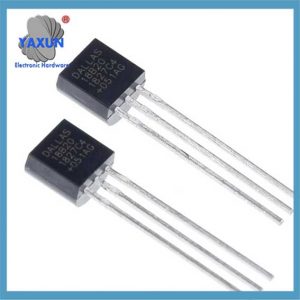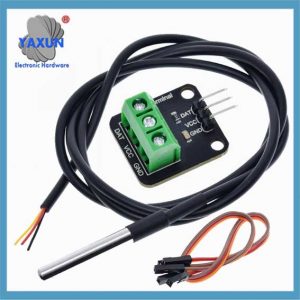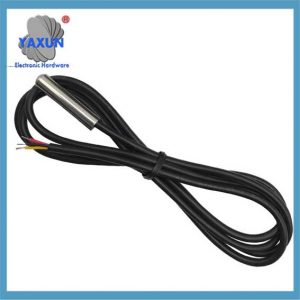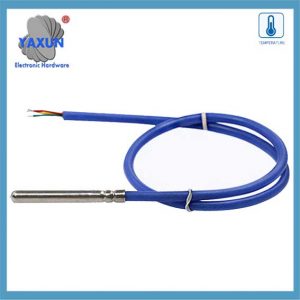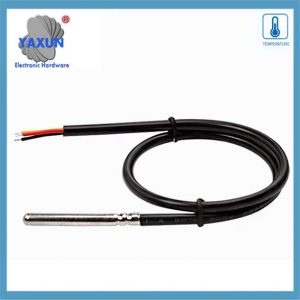We offer a wide range of the best 1-Wire DS18B20 sensor connectors, including Nanoflex, DisplayPort, USB, Solar, SATA, HDMI, ATA IDE, SAS & many more. All cables are manufactured to the highest industry standards. Using Sensor Circuit Assembly for box builds allows you to focus on your design and marketing, reduce costs, and reap the benefits of our assembly lines, QA processes, and manufacturing expertise.
The DS18B20 sensor communicates using the “1-سیم” protocol, which means it uses a single data line for all communication with a microcontroller, allowing multiple sensors to be connected on the same line and identified by their unique 64-bit serial code; this single data line is pulled high with a resistor and the sensor transmits data by pulling the line low during specific time slots to send bits of information.
سنسور دما DS18B20: The DS18B20 waterproof probe is designed for underwater use, capable of operating in wet or moist environments without being damaged by water or moisture.
Temperature sensor supply voltage: 3.0V ~ 5.25V;
محدوده دمای عملیاتی:-55 ℃ به +125 ℃ (-67 ℉ to +257 ℉);
Provides from 9-bit to 12-bit Celsius temperature measurements;
Adapter module is equipped with a pull-up resistor, and directly connects to the GPIO of the Raspberry Pi without an external resistor;
Use this adapter module kit to simplify connecting the waterproof temperature sensor to your project.
1. Key points about the 1-Wire protocol:
Single data line:
Only one wire is needed for communication between the sensor and the microcontroller.
Half-duplex communication:
Data can be sent in both directions, but only one direction at a time.
Parasite power:
The DS18B20 can be powered directly from the data line during communication, eliminating the need for a separate power supply in some cases.
Unique device addresses:
Each DS18B20 sensor has a unique 64-bit serial code that allows the microcontroller to identify and address individual sensors on the bus.
Communication steps with a DS18B20:
1.1 Reset pulse:
The microcontroller initiates communication by pulling the data line low for a specific duration (reset pulse).
1.2 Presence pulse:
If a DS18B20 is present on the bus, it will respond with a short pulse, indicating its presence.
1.3 ROM command:
The microcontroller sends a ROM command to either read the unique 64-bit code of a specific sensor (“Match ROM”) or to address all sensors on the bus (“Skip ROM”).
1.4 Function command:
Depending on the desired operation (like reading temperature), the microcontroller sends a specific function command to the sensor.
1.5 Data transfer:
Data is transmitted bit-by-bit, with the sensor pulling the data line low to send a ‘0’ and letting the line go high to send a ‘1’.
2. توضیحات دقیق درباره پروتکل ارتباطی 1 سیم DS18B20
دلیل استفاده گسترده از سنسورهای DS18B20 تا حد زیادی به دلیل پروتکل ارتباطی منحصر به فرد آن است – 1-پروتکل ارتباطی سیم. این پروتکل الزامات مربوط به اتصالات سخت افزاری را ساده می کند و روشی کارآمد برای انتقال داده ها فراهم می کند. در این فصل به طور عمیق مکانیسم کار و فرآیند تبادل داده پروتکل ارتباطی 1 خطی را تجزیه و تحلیل می کند تا پایه و اساس محکمی برای تمرین برنامه نویسی بعدی ایجاد کند.
2.1 مبانی پروتکل ارتباطی 1 سیم
2.1.1 ویژگی های پروتکل ارتباطی 1 سیم:
پروتکل ارتباطی 1 سیم DS18B20 نیز نامیده می شود “تک اتوبوس” فناوری. این ویژگی های زیر را دارد: – ارتباطات تک اتوبوس: فقط یک خط داده برای انتقال داده های دو طرفه استفاده می شود, که پیچیدگی سیم کشی را در مقایسه با روش ارتباط سنتی سنسور چند سیم کاهش می دهد. – اتصال چند دستگاهی: از اتصال چندین دستگاه در یک اتوبوس داده پشتیبانی می کند, و از طریق کدهای شناسایی دستگاه شناسایی و ارتباط برقرار می کند. – مصرف انرژی کم: در حین برقراری, این دستگاه هنگام شرکت در ارتباطات می تواند در حالت آماده به کار کم قدرت قرار داشته باشد. – با دقت بالا: با زمان انتقال داده کوتاه تر, این می تواند تداخل خارجی را کاهش داده و دقت داده ها را بهبود بخشد.
2.1.2 قالب داده ها و تجزیه و تحلیل زمان بندی ارتباط 1 سیم
قالب داده پروتکل ارتباطی 1 سیم از یک قانون زمان بندی خاص پیروی می کند. این شامل زمان بندی اولیه سازی است, زمان بندی را بنویسید و زمان بندی را بخوانید:
زمان بندی اولیه سازی: میزبان ابتدا زمان تشخیص حضور را شروع می کند (نبض حضور) با پایین کشیدن اتوبوس برای مدت معینی, و سنسور سپس یک پالس حضور در پاسخ می فرستد.
زمان نوشتن: وقتی میزبان زمان نوشتن را ارسال می کند, ابتدا اتوبوس را در حدود پایین می کشد 1-15 میکرو ثانیه, سپس اتوبوس را آزاد می کند, و سنسور اتوبوس را پایین می آورد 60-120 میکرو ثانیه ها برای پاسخ دادن.
زمان را بخوانید: میزبان با کشیدن اتوبوس و رها کردن آن ، سنسور را به ارسال داده ها اطلاع می دهد, و سنسور پس از تأخیر خاص ، بیت داده را در اتوبوس خروجی می کند.
2.2 Software implementation of data communication
2.2.1 Initialization and reset of 1-line communication
At the software level, initialization and reset of 1-Wire communication is the first step of communication. The following is the pseudo code to implement this process:
// OneWire communication initialization function
void OneWire_Init() {
// Set the bus to input mode and enable the pull-up resistor
SetPinMode(DS18B20_PIN, INPUT_PULLUP);
// Wait for the bus to be idle
DelayMicroseconds(1);
// Send a reset pulse
OneWire_Reset();
}
// OneWire communication reset function
void OneWire_Reset() {
// Pull down the bus
SetPinMode(DS18B20_PIN, OUTPUT_LOW);
DelayMicroseconds(480);
// Release the bus
SetPinMode(DS18B20_PIN, INPUT_PULLUP);
DelayMicroseconds(70);
// Wait for the presence of a pulse
اگر (!WaitForOneWirePresence())
// No pulse was detected, maybe the sensor is not connected or the initialization failed
HandleError();
DelayMicroseconds(410);
}
// Waiting for the presence of a pulse
bool WaitForOneWirePresence() {
return ReadPin(DS18B20_PIN) == 0; // Assume low level is a signal presence
}
2.2.2 Data reading and writing operations
Data reading and writing operations are the core part of sensor communication. The following code shows how to write a byte to a one-wire bus:
// Write a byte to a one-wire bus
void OneWire_WriteByte(byte data) {
for (int i = 0; i < 8; i++) {
OneWire_WriteBit(data & 0x01);
data >>= 1;
}
}
// Write a bit to a one-wire bus
void OneWire_WriteBit(bit data) {
SetPinMode(DS18B20_PIN, OUTPUT_LOW);
اگر (data) {
// Release the bus when writing 1
SetPinMode(DS18B20_PIN, INPUT_PULLUP);
DelayMicroseconds(1);
} دیگر {
// Continue to pull the bus low when writing 0
DelayMicroseconds(60);
}
SetPinMode(DS18B20_PIN, INPUT_PULLUP);
DelayMicroseconds(1);
}
Next is the function to read a byte:
// Read a byte from the one-wire bus
byte OneWire_ReadByte() {
byte data = 0;
for (int i = 0; i < 8; i++) {
data >>= 1;
اگر (OneWire_ReadBit())
data |= 0x80;
}
return data;
}
// Read a bit from the one-wire bus
bit OneWire_ReadBit() {
SetPinMode(DS18B20_PIN, OUTPUT_LOW);
SetPinMode(DS18B20_PIN, INPUT_PULLUP);
DelayMicroseconds(3);
bool result = ReadPin(DS18B20_PIN);
DelayMicroseconds(57);
return result;
}
2.2.3 Verification mechanism of OneWire communication
The OneWire communication protocol uses a simple verification mechanism in the data exchange process, usually by reading back the written data to verify the correctness of the data. The following is a sample code for verifying the written data:
byte data = 0x55; // Assume that the data to be sent
OneWire_WriteByte(data); // Write data to the OneWire bus
byte readData = OneWire_ReadByte(); // Read back data from the OneWire bus
اگر (readData != data) {
HandleError(); // If the read-back data does not match the written data, handle the error
 English
English Afrikaans
Afrikaans العربية
العربية বাংলা
বাংলা bosanski jezik
bosanski jezik Български
Български Català
Català 粤语
粤语 中文(简体)
中文(简体) 中文(漢字)
中文(漢字) Hrvatski
Hrvatski Čeština
Čeština Nederlands
Nederlands Eesti keel
Eesti keel Suomi
Suomi Français
Français Deutsch
Deutsch Ελληνικά
Ελληνικά हिन्दी; हिंदी
हिन्दी; हिंदी Magyar
Magyar Bahasa Indonesia
Bahasa Indonesia Italiano
Italiano 日本語
日本語 한국어
한국어 Latviešu valoda
Latviešu valoda Lietuvių kalba
Lietuvių kalba македонски јазик
македонски јазик Bahasa Melayu
Bahasa Melayu Norsk
Norsk پارسی
پارسی Polski
Polski Português
Português Română
Română Русский
Русский Cрпски језик
Cрпски језик Slovenčina
Slovenčina Slovenščina
Slovenščina Español
Español Svenska
Svenska ภาษาไทย
ภาษาไทย Türkçe
Türkçe Українська
Українська اردو
اردو Tiếng Việt
Tiếng Việt

